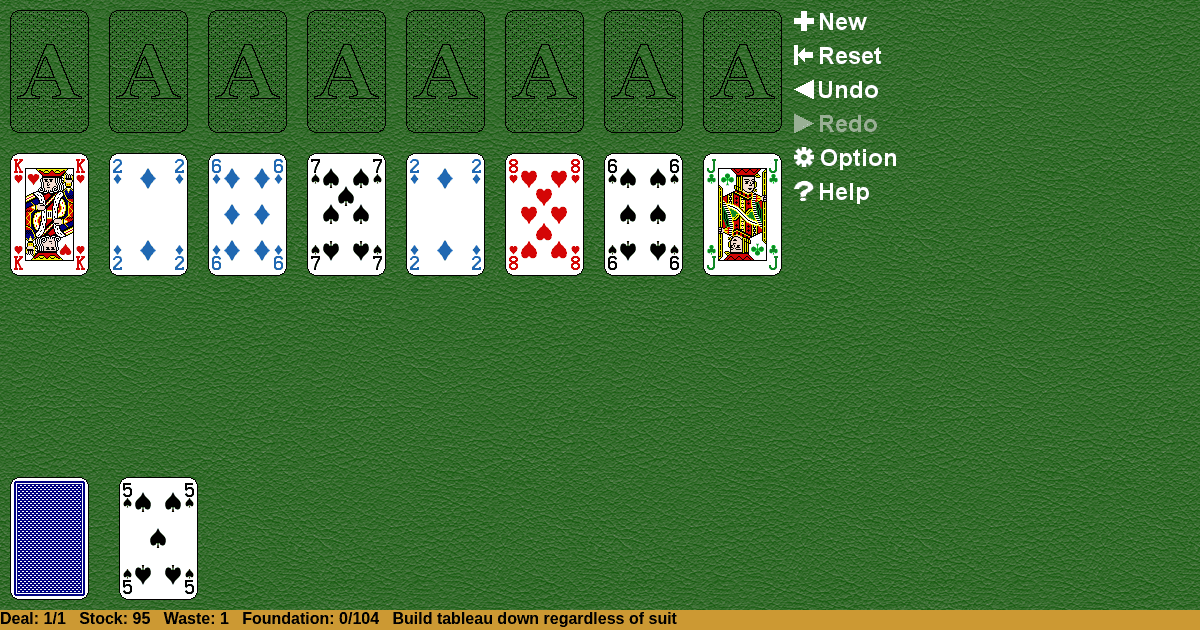Congress
Home |
How to play |
FAQ |
About
How to play Congress?
Game Objective:
The primary goal in Congress Solitaire is to move all cards from the tableau and stock to the eight foundation piles, building each foundation up by suit from Ace to King.
Setup & Layout:
- Deck: Congress Solitaire uses two standard 52-card decks, totaling 104 cards.
- Tableau: Eight tableau piles are created, each with one card dealt face-up. These piles are arranged in two columns of four cards each, flanking the foundation area.
- Foundations: Eight foundation spaces are positioned between the tableau columns. These start empty and are filled by Aces as they become available.
- Stock: The remaining cards form the stock pile, placed face-down.
- Waste: A single waste pile is used. Cards from the stock are dealt face-up onto the waste pile.
- Face-Up/Face-Down: All tableau cards are dealt face-up. The stock is face-down until cards are drawn; the waste is always face-up.
Congress Solitaire Rules:
- Foundations:
- Build each foundation pile up by suit, starting with Ace and ending with King (e.g., Ace♠, 2♠, 3♠ … King♠).
- Only Aces may start a foundation; they are moved as they become available.
- Tableau:
- Build tableau piles down by rank, regardless of suit (e.g., 9♣ can be placed on 10♦).
- Only the top card of each tableau pile may be moved at any time.
- Cards are moved one at a time; sequences cannot be moved.
- Stock and Waste:
- When no more moves are available, deal one card at a time from the stock to the waste pile.
- The top card of the waste pile is available for play to the tableau or foundation.
- There is no redeal; the stock is used only once.
- Empty Spaces:
- Empty tableau piles are automatically filled from the waste or stock.
- If both stock and waste are empty, tableau spaces remain empty.
Gameplay:
- Begin by examining the tableau and moving any available Aces to the foundation area.
- Build tableau piles down by rank, regardless of suit, using only the top card of each pile.
- Move cards to the foundations whenever possible, building up by suit from Ace to King.
- When no more moves can be made, deal one card from the stock to the waste pile. Use the top card of the waste for further moves.
- Continue alternating between making moves and dealing from the stock until the stock is exhausted.
- Play ends when all cards are moved to the foundations or no further moves are possible.
Winning & Losing Conditions:
- Win: The game is won when all eight foundations are complete (each built up from Ace to King in its suit).
- Loss: The game is lost if the stock is exhausted and no further legal moves are possible, leaving cards stranded in the tableau or waste.
Special Rules & Edge Cases:
- Filling Empty Tableau Spaces: Empty tableau piles are filled automatically from the waste or stock. If both are empty, spaces remain vacant.
- Card Movement Restrictions: Only one card may be moved at a time; sequences cannot be moved between tableau piles.
- No Redeal: Once the stock is depleted, no cards are returned or shuffled; play continues only with cards in the tableau and waste.
- Edge Case—No Available Moves: If all tableau piles are blocked and the stock is depleted, the game ends in a loss.
Key Definitions:
- Tableau: The main play area with eight piles, each starting with one face-up card.
- Foundation: The target area for building up cards by suit from Ace to King.
- Stock: The face-down pile supplying new cards.
- Waste: The face-up pile where cards from the stock are placed and made available for play.
This guide provides a semantically precise overview of Congress Solitaire’s unique rules and gameplay mechanics, optimized for clarity and reference.

Solitaire Collection
About Congress
Rate (Congress)
4.7 / 5
1,916 votes



























































